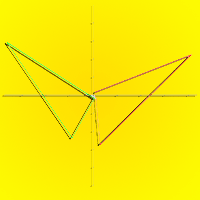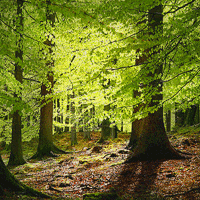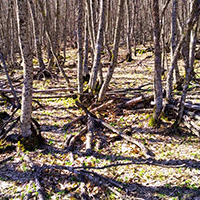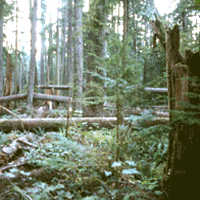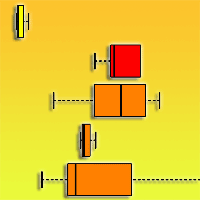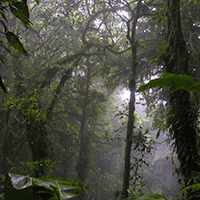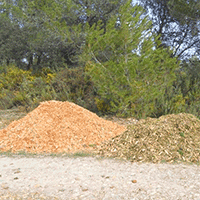Coarse woody debris (CWD) has a wide range of ecological and conservation values such as maintaining biodiversity in forest ecosystems. Each forest management method can have a detrimental effect on stand structure and CWD. We analyzed the volume and density of live trees and CWD (snags and downed logs) over a long-term (30 years) selection-logging managed compartment (harvested), and compared these with values obtained from an unlogged compartment (control) in the Iranian Caspian forests. Results showed that the volume and density of live trees and CWD in the harvested area was significantly lower than in the control area, especially large size trees and CWD, very decayed CWD, and rare tree species. The ratio of snags volume to total standing volume (RSS) was significantly higher in the control (7.9%) than in the harvested area (5.2%), and the ratio of downed logs volume to trees volume (RDT) in the control area (6.3%) was significantly higher than in the harvested area (4.6%), while the ratio of downed logs volume to snags volume (RDS) was significantly higher in the harvested area (83.6%) than in the control (74%). Based on the obtained results, we recommend selection cutting forests to be managed based on CWD management plans, including appropriate cutting cycles (15-30 years) and retention of large-diameter (DBH > 75 cm) and cavity trees as a suitable habitat for many wildlife species.
Keywords
, , , ,
Citation
Tavankar F, Nikooy M, Picchio R, Venanzi R, Lo Monaco A (2017). Long-term effects of single-tree selection cutting management on coarse woody debris in natural mixed beech stands in the Caspian forest (Iran). iForest 10: 652-658. - doi: 10.3832/ifor2091-010
Academic Editor
Andrea Cutini
Paper history
Received: Apr 20, 2016
Accepted: Apr 10, 2017
First online: Jun 20, 2017
Publication Date: Jun 30, 2017
Publication Time: 2.37 months
© SISEF - The Italian Society of Silviculture and Forest Ecology 2017
Open Access
This article is distributed under the terms of the Creative Commons Attribution-Non Commercial 4.0 International (https://creativecommons.org/licenses/by-nc/4.0/), which permits unrestricted use, distribution, and reproduction in any medium, provided you give appropriate credit to the original author(s) and the source, provide a link to the Creative Commons license, and indicate if changes were made.

Breakdown by View Type
(Waiting for server response...)
Article Usage
Total Article Views: 48317
(from publication date up to now)
Breakdown by View Type
HTML Page Views: 40122
Abstract Page Views: 3009
PDF Downloads: 4002
Citation/Reference Downloads: 18
XML Downloads: 1166
Web Metrics
Days since publication: 3097
Overall contacts: 48317
Avg. contacts per week: 109.21
Article Citations
Article citations are based on data periodically collected from the Clarivate Web of Science web site
(last update: Mar 2025)
Total number of cites (since 2017): 15
Average cites per year: 1.67
Publication Metrics
by Dimensions ©
Articles citing this article
List of the papers citing this article based on CrossRef Cited-by.
(1)
Abkenari KT, Akbari F, Pilehvar B (2012)Effect of intervention and type of forest management on quality and quantity characteristics of dead wood in managed and reserve forests: a case study. Journal of Forestry Research 23 (3): 413-418.
CrossRef |
Gscholar
(2)
Angers VA, Drapeau P, Bergeron Y (2012)Mineralization rates and factors influencing snag decay in four North American boreal tree species. Canadian Journal of Forest Research 42 (1): 157-166.
CrossRef |
Gscholar
(3)
Barreca L, Cutini A, Mercurio R (2008)Dead wood characterisation in
Quercus frainetto stands in Calabria (Southern Italy). Forest@ 5 (1): 187-194. [in Italian with English summary]
CrossRef |
Gscholar
(4)
Behjou FK, Mollabashi OG, Amirahamdi N (2014)Effect of management on the amount and characteristics of wood debris in mixed stands of Caspian forest. BioResources 9 (3): 4108-4116.
Gscholar
(5)
Boulanger Y, Sirois L (2006)Postfire dynamics of black spruce coarse woody debris in northern boreal forest of Quebec. Canadian Journal of Forest Research 36 (7): 1770-1780.
CrossRef |
Gscholar
(6)
Carmichael DB, Guynn DC (1983)Snag density and utilization by wildlife in the upper Piedmont of South Carolina. In: Proceedings of the Symposium “Snag Habitat Management”. Flagstaff (AZ, USA) 7-9 Jun 1983. General Technical Report RM-99, Rocky Mountain Forest and Range Experiment Station, USDA Forest Service, Fort Collins, CO, USA, pp. 107-110.
Online |
Gscholar
(7)
Castagneri D, Garbarino M, Berretti R, Motta R (2010)Site and stand effects on coarse woody debris in montane mixed forests of Eastern Italian Alps. Forest Ecology and Management 260 (9): 1592-1598.
CrossRef |
Gscholar
(8)
Christensen M, Hahn K, Mountford EP, Odor P, Standovar T, Rozenbergar D, Diaci J, Wijdeven S, Meyer P, Winter S, Vrska T (2005)Dead wood in European beech (
Fagus sylvatica) forest reserves. Forest Ecology and Management 210: 267-282.
CrossRef |
Gscholar
(9)
Coppini M, Hermanin L (2007)Restoration of selective beech coppices: a case study in the Apennines (Italy). Forest Ecology and Management 249: 18-27.
CrossRef |
Gscholar
(10)
Corace RG, Seefelt NE, Goebel PC, Shaw HL (2010)Snag longevity and decay class development in a recent Jack Pine clearcut in Michigan. Northern Journal of Applied Forestry 27 (4): 125-131.
Gscholar
(11)
De Groot M, Eler K, Flajšman K, Grebenc T, Marinšek A, Kutnar L (2016)Differential short-term response of functional groups to a change in forest management in a temperate forest. Forest Ecology and Management 376: 256-264.
CrossRef |
Gscholar
(12)
De Long SC, Sutherland GD, Daniels LD, Heemskerk BH, Storaunet KO (2008)Temporal dynamics of snags and development of snag habitats in wet spruce-fir stands in east-central British Columbia. Forest Ecology and Management 255 (10): 3613-3620.
CrossRef |
Gscholar
(13)
Everett R, Lehmkuhl J, Schellhaas R, Ohlson P, Keenum D, Riesterer H, Spurbeck D (1999)Snag dynamics in a chronosequence of 26 wildfires on the east slope of the Cascade Range in Washington State, USA. International Journal of Wildland Fire 9 (4): 223-234.
CrossRef |
Gscholar
(14)
Ghadiri Khanaposhtani M, Kaboli M, Karami M, Etemad V (2012)Effect of habitat complexity on richness, abundance and distributional pattern of forest birds. Environmental Management 50: 296-303.
CrossRef |
Gscholar
(15)
Ghadiri Khanaposhtani M, Kaboli M, Karami M, Etemad V, Baniasadi S (2013)Effects of logged and unlogged forest patches on avifaunal diversity. Environmental Management 51 (3): 750-758.
CrossRef |
Gscholar
(16)
Hanberry BB, Hanberry P, Demarais S, Jones JC (2012)Importance of residual trees to birds in regenerating pine plantations. iForest 5: 108-112.
CrossRef |
Gscholar
(17)
Hansen AJ, Spies TA, Swanson FJ, Ohmann TL (1991)Conserving biodiversity in managed forests. BioScience 41 (6): 382-392.
CrossRef |
Gscholar
(18)
Kenefic LS, Nyland RD (2007)Cavity trees, snags, and selection cutting: a northern hardwood case study. Northern Journal of Applied Forestry 24 (3): 192-196.
Online |
Gscholar
(19)
Lombardi F, Cherubini P, Lasserre B, Tognetti R, Marchetti M (2008)Tree rings used to assess time since death of deadwood of different decay classes in beech and silver fir forests in the central Apennines (Molise, Italy). Canadian Journal of Forest Research 38 (4): 821-833.
CrossRef |
Gscholar
(20)
Lučan RK, Hanák V, Horáček I (2009)Long-term re-use of tree roosts by European forest bats. Forest Ecology and Management 258 (7): 1301-1306.
CrossRef |
Gscholar
(21)
Martin SH, Barrett RH (1983)The importance of snags to Pine Marten habitat in the Northern Sierra Nevada. In: Proceedings of the Symposium “Snag Habitat Management”. Flagstaff (AZ, USA) 7-9 Jun 1983. General Technical Report RM-99, Rocky Mountain Forest and Range Experiment Station, USDA Forest Service, Fort Collins, CO, USA, pp. 114-116.
Gscholar
(22)
Mason F, Zapponi L (2015)The forest biodiversity artery: towards forest management for saproxylic conservation. iForest 9: 205-216.
CrossRef |
Gscholar
(23)
Matsuzaki E, Sanborn P, Fredeen AL, Shaw CH, Hawkins C (2013)Carbon stocks in managed and unmanaged old-growth western red cedar and western hemlock stands of Canada’s inland temperate rainforests. Forest Ecology and Management 297: 108-119.
CrossRef |
Gscholar
(24)
McComb WC, Noble RE (1980)Effects of single-tree selection cutting upon snag and natural cavity characteristics in Connecticut. Transactions of the Northeast Section of the Wildlife Society 37: 50-57.
Gscholar
(25)
McComb WC, Muller RN (1983)Snag densities in old-growth and second-growth Appalachian forests. Journal of Wildlife Management 47 (2): 376-382.
CrossRef |
Gscholar
(26)
Moriarty JJ, McComb WC (1983)The long-term effect of timber stand improvement on snag and cavity densities in the Central Appalachians. In: Proceedings of the Symposium “Snag Habitat Management”. Flagstaff (AZ, USA) 7-9 Jun 1983. General Technical Report RM-99, Rocky Mountain Forest and Range Experiment Station, USDA Forest Service, Fort Collins, CO, USA, pp. 40-44.
Online |
Gscholar
(27)
Müller J, Horton T, Pretzsch H (2007)Long-term effects of logging intensity on structures, birds, saproxylic beetles and wood-inhabiting fungi in stands of European beech
Fagus sylvatica L. Forest Ecology and Management 242: 297-305.
CrossRef |
Gscholar
(28)
Müller-Using S, Bartsch N (2009)Decay dynamic of coarse and fine woody debris of a beech (
Fagus sylvatica L.) forest in Central Germany. European Journal of Forest Research 128 (3): 287-296.
CrossRef |
Gscholar
(29)
Nilsson SG, Niklasson M, Hedin J, Aronsson G, Gutowski JM, Linder P, Ljungberg H, MikusiÅski G, Ranius T (2002)Densities of large living and dead trees in old-growth temperate and boreal forests. Forest Ecology and Management 161 (1-3): 189-204.
CrossRef |
Gscholar
(30)
Ohmann JL, McComb WC, Zumrawi AA (1994)Snag abundance for primary cavity nesting birds on nonfederal forest lands in Oregon and Washington. Wildlife Society Bulletin 22 (4): 607-620.
Online |
Gscholar
(31)
Paletto A, De Meo I, Cantiani P, Ferretti F (2014)Effects of forest management on the amount of deadwood in Mediterranean oak ecosystems. Annals of Forest Science 71 (7): 791-800.
CrossRef |
Gscholar
(32)
Pamerleau-Couture E, Krause C, Pothier D, Weiskittel A (2015)Effect of three partial cutting practices on stand structure and growth of residual black spruce trees in north-eastern Quebec. Forestry 88 (4): 471-483.
CrossRef |
Gscholar
(33)
Payer DC, Harrison DJ (2003)Influence of forest structure on habitat use by American marten in an industrial forest. Forest Ecology and Management 179 (1-3): 145-156.
CrossRef |
Gscholar
(34)
Perry RW, Thill RE (2013)Comparison of snag densities among regeneration treatments in mixed pine-hardwood forests. Canadian Journal of Forest Research 43 (7): 619-626.
CrossRef |
Gscholar
(35)
Picchio R, Spina R, Calienno L, Venanzi R, Lo Monaco A (2016)Forest operations for implementing silvicultural treatments for multiple purposes. Italian Journal of Agronomy 11: 156-161.
Gscholar
(36)
Rose CL, Marcot BG, Mellen TK, Ohmann JL, Wadell KL, Lindley DL, Schreiber B (2001)Decaying wood in Pacific Northwest Forests: concepts and tools for habitat management. Oregon State University Press, Corvallis, OR, USA, pp. 580-623.
Gscholar
(37)
Russell MB, Kenefic LS, Weiskitte AR, Puhlick JJ, Brissette JC (2012)Assessing and modeling standing deadwood attributes under alternative silvicultural regimes in the Acadian forest region of Maine, USA. Canadian Journal of Forest Research 42: 1873-1883.
CrossRef |
Gscholar
(38)
Sefidi K, Marvie Mohadjer MR (2010)Characteristics of coarse woody debris in successional stages of natural beech (
Fagus orientalis) forests of Northern Iran. Journal of Forest Science 56 (1): 7-17.
Online |
Gscholar
(39)
Sefidi K, Marvie Mohadjer MR, Mosandl R, Copenheaver C (2013)Coarse and fine woody debris in mature Oriental Beech. Natural Areas Journal 33 (3): 248-255.
CrossRef |
Gscholar
(40)
Strukelj M, Brais S, Quideaua SA, Angers VA, Kebli H, Drapeau P, Oh S (2013)Chemical transformations in downed logs and snags of mixed boreal species during decomposition. Canadian Journal of Forest Research 43 (9): 785-798.
CrossRef |
Gscholar
(41)
Tabari M, Fayaz P, Espahbodi K, Staelens J, Nachtergale L (2005)Response of oriental beech (
Fagus orientalis Lipsky) seedlings to canopy gap size. Forestry 78 (4): 443-450.
CrossRef |
Gscholar
(42)
Tavankar F, Bonyad AE, Iranparast Bodaghi A (2013)Effects of snags on the species diversity and frequency of tree natural regeneration in natural forest ecosystems of Guilan. Iranian Journal of Plant Researches 26 (3): 267-280.
Gscholar
(43)
Tavankar F, Picchio R, Lo Monaco AR, Bonyad AE (2014)Forest management and snag characteristics in Northern Iran lowland forests. Journal of Forest Science 60 (10): 431-441.
Online |
Gscholar
(44)
Wisdom MJ, Bate LJ (2008)Snag density varies with intensity of timber harvest and human access. Forest Ecology and Management 255 (7): 2085-2093.
CrossRef |
Gscholar
(45)
Ziaco E, Di Filippo A, Alessandrini A, Baliva M, D’Andrea E, Piovesan G (2012)Old-growth attributes in a network of Apennines (Italy) beech forests: disentangling the role of past human interferences and biogeoclimate. Plant Biosystems 146 (1): 153-166.
CrossRef |
Gscholar
(46)
Zielonka T (2006)Quantity and decay stages of coarse woody debris in old-growth subalpine spruce forests of the western Carpathians. Poland. Canadian Journal of Forest Research 36 (10): 2614-2622.
CrossRef |
Gscholar
